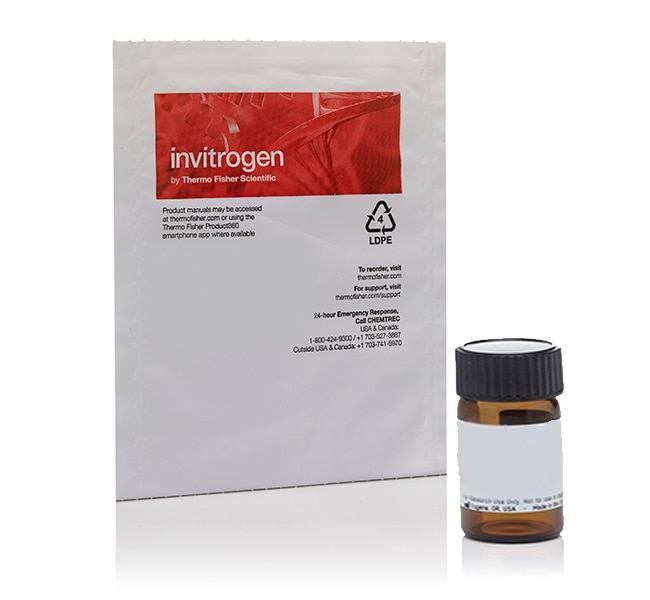Search Thermo Fisher Scientific

Certificates
SDS
Citations & References (187)
Invitrogen™
Nile Red
Nile red is used to localize and quantitate lipids, particularly neutral lipid droplets within cells. Nile red is almost nonfluorescentRead more
 Promotion
PromotionPromo code:P5906365
Don't miss out: buy 3, only pay for 2
 Promotion
PromotionPromo code:RPUZZ25
Stock up on essentials to piece your discovery together
| Catalog Number | Quantity |
|---|---|
N1142 | 25 mg |
Catalog number N1142
Price (USD)
231.00
Each
In stock
Quantity:
25 mg
Price (USD)
231.00
Each
Nile red is used to localize and quantitate lipids, particularly neutral lipid droplets within cells. Nile red is almost nonfluorescent in water and other polar solvents but undergoes fluorescence enhancement and large absorption and emission blue shifts in nonpolar environments (Excitation/emission maxima ∼552/636 nm in methanol).
We recommend dissolving in high-quality anhydrous DMSO or DMF to attain a stock concentration up to 1 mM.
We recommend dissolving in high-quality anhydrous DMSO or DMF to attain a stock concentration up to 1 mM.
For Research Use Only. Not for use in diagnostic procedures.
Specifications
Detection MethodFluorescence
Excitation/Emission552/636 nm
For Use With (Equipment)Fluorescence Microscope
Molecular FormulaC20H18N2O2
Quantity25 mg
Recommended StorageStore at room temperature and protect from light.
Shipping ConditionRoom Temperature
Sub Cellular LocalizationCell Membranes & Lipids, Lysosomes
ColorRed
Physical FormSolid
Product TypeNile Red Stain
Unit SizeEach
Have questions about this product? Ask our AI assisted search.
This is an AI-powered search and may not always get things right. You can help us make it better with a thumbs up or down on individual answers or by selecting the “Give feedback" button. Your search history and customer login information may be retained by Thermo Fisher and processed in accordance with our
Privacy Notice.
Figures

Chemical Structure
Customers who viewed this item also viewed
Documents & Downloads
Certificates
Search by lot number or partial lot number
Lot #Certificate TypeDateCatalog Number(s)
3192601Certificate of AnalysisJun 01, 2025N1142
3148291Certificate of AnalysisMar 31, 2025N1142
3135154Certificate of AnalysisJan 21, 2025N1142
3118575Certificate of AnalysisJan 04, 2025N1142
3023505Certificate of AnalysisAug 19, 2024N1142
5 results displayed, search above for a specific certificate
Safety Data Sheets
SDS
Citations & References (187)
Search citations by name, author, journal title or abstract text
Citations & References
Abstract
Developmental shift in the relative percentages of lung fibroblast subsets: role of apoptosis postseptation.
Journal:The American journal of physiology
PubMed ID:10516228
Global metabolic profiling of infection by an oncogenic virus: KSHV induces and requires lipogenesis for survival of latent infection.
Journal:PLoS Pathog
PubMed ID:22916018
Like cancer cells, virally infected cells have dramatically altered metabolic requirements. We analyzed global metabolic changes induced by latent infection with an oncogenic virus, Kaposi's Sarcoma-associated herpesvirus (KSHV). KSHV is the etiologic agent of Kaposi's Sarcoma (KS), the most common tumor of AIDS patients. Approximately one-third of the nearly 200
Three-colour fluorescence immunohistochemistry reveals the diversity of cells staining for macrophage markers in murine spleen and liver.
Journal:J Immunol Methods
PubMed ID:18367204
'Macrophages have traditionally been identified in murine tissues using a small range of markers, typically F4/80, CD68 and CD11b. However many studies have suggested that substantial heterogeneity exists in macrophage populations, and no single marker, nor even pair of markers, can necessarily identify all the populations. Further, many of the
Lipid-dependent bidirectional traffic of apolipoprotein B in polarized enterocytes.
Journal:Mol Biol Cell
PubMed ID:14565984
'Enterocytes are highly polarized cells that transfer nutrients across the intestinal epithelium from the apical to the basolateral pole. Apolipoprotein B (apoB) is a secretory protein that plays a key role in the transepithelial transport of dietary fatty acids as triacylglycerol. The evaluation of the control of apoB traffic by
Functional analysis of FSP27 protein regions for lipid droplet localization, caspase-dependent apoptosis, and dimerization with CIDEA.
Journal:Am J Physiol Endocrinol Metab
PubMed ID:19843876
'The adipocyte-specific protein FSP27, also known as CIDEC, is one of three cell death-inducing DFF45-like effector (CIDE) proteins. The first known function for CIDEs was promotion of apoptosis upon ectopic expression in mammalian cells. Recent studies in endogenous settings demonstrated key roles for CIDEs in energy metabolism. FSP27 is a
187 total citations
